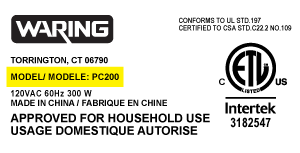11018609890 Kenmore Washer - Instructions
Keep searches simple. Use keywords, e.g. "leaking", "pump", "broken" or "fit".
washer moving 3 ft during the spin cycle sounding like elephants running through the house
Removed back panel to remove tub from shell. Unscrewed the brackets holding the springs. Used screw driver to pop out pads with hammer onto screw driver. Cleaned out tub and put grease on springs where they attach to bracket. Replaced panel and ran machine to find a leak. Took machine apart again to find the knocking of the tub against the back panel caused a whole in the plastic tub. Silicon and mechanical tape. Washer works fine for now.
Parts Used:
-
Annie from Haines, OR
-
Difficulty Level:A Bit Difficult
-
Total Repair Time:More than 2 hours
-
Tools:Pliers, Screw drivers, Socket set, Wrench (Adjustable), Wrench set
28 of 36 people
found this instruction helpful.
Was this instruction helpful to you?
Thank you for voting!
Two leaking hoses in my washing machine
Put the machine on its side. Remove old hoses and screw new ones into place. Done in under 20 minutes.
Parts Used:
-
Marc from Morton Grove, IL
-
Difficulty Level:Really Easy
-
Total Repair Time:15 - 30 mins
-
Tools:Pliers, Screw drivers
29 of 39 people
found this instruction helpful.
Was this instruction helpful to you?
Thank you for voting!
Agitator loose spinning
Three of the four agitator cogs had broken. The agitator was able to spin freely both clockwise encounter clockwise which it should not be doing. I replaced the cogs as well as a couple additional parts just to be sure but the cogs were the important one. Very easy.
Parts Used:
-
Matthew from AUSTIN, TX
-
Difficulty Level:Easy
-
Total Repair Time:30 - 60 mins
-
Tools:Socket set
24 of 25 people
found this instruction helpful.
Was this instruction helpful to you?
Thank you for voting!
Agitator was locked up
I had a little difficulty at first, trying to remove the back of the unit. I then figured out that the repair was to be made by leaning the washer back and removing it from underneath. That became really easy as the bottom is open.I had to remove one nut and then the agitator from inside, then tilt the machine back, disconnect the two hoses from the pump, remove three bolts and lower the motor/ transmission assembly. Then I had to disconnect the motor from the pump ( with two snap on clips) and remove the broken plastic coupling. The new coupling had a metal insert that seems to make it stronger than the original piece.I then just reversed the procedure to put it together again and it worked fine. The part was shipped immediately and I got it sooner than I expected so I greatly appreciate that. Overall it went well, and by the way, it was my daughters washer and she was happy as well.Thanks, Roger
Parts Used:
-
Roger from Palmyra, IN
-
Difficulty Level:Easy
-
Total Repair Time:30 - 60 mins
-
Tools:Nutdriver, Pliers, Screw drivers, Socket set
24 of 28 people
found this instruction helpful.
Was this instruction helpful to you?
Thank you for voting!
The spin gear was striped.
I had to take the motor and transmission out. They are one piece. Removed the clutch, take off trans. cover, remove a snap ring, take the striped gear off, and put the new one on. Then put put everything back on the way it came off.
Parts Used:
-
Aaron from Lake Mills, WI
-
Difficulty Level:A Bit Difficult
-
Total Repair Time:1- 2 hours
-
Tools:Pliers, Socket set
25 of 31 people
found this instruction helpful.
Was this instruction helpful to you?
Thank you for voting!
Scratches in Surface
This product comes in a bottle with a brush like Liquid Paper. It goes on incredibly easy. A second coat might be needed. I wanted to prevent rust from setting in so I covered the scratches and dings. The paint is a little brighter since my washer is 10 years old but it still looks great.
Parts Used:
-
Michelle from Richardson, TX
-
Difficulty Level:Really Easy
-
Total Repair Time:Less than 15 mins
75 of 181 people
found this instruction helpful.
Was this instruction helpful to you?
Thank you for voting!
Excessive tub wobble, tubs leaning forward of normal
Washer is 29 years old. Found that tub spring hooks into a simple (non-reinforced) hole in the base frame, and it had worn the hole through through the edge of the frame (key hole style). Due to age and low cost of parts, ordered all suspension springs, brackets, & pads. Once they arrived, took the tubs out (first time for that), found that the suspension pads looked fine, but the wear pads showed a lot of wear and the front one was snapped in the middle, perhaps an after effect of the spring failure. From my lack of attention, initially tried to get front pad into the wrong set of holes, a bad fit; corrected. Simply drilled a near-by hole in the base frame for the tub spring.
While the tubs were out, took them outside and scrubbed them clean. Also cleaned agitator parts using bottle brushes. Followed the PartSelect videos and owner comments for procedures, methods. Found that some miss some important info, but if you watch others you can combine the info to find what you need re disassembly/assembly.
At one point while attempting to remove the outer tub, did not realize that the screw that holds the rear spring bracket to the tub also holds the tub to the suspension plate.
Took me most of a day for the whole process, and I ended up with pulled/spasmic muscles from all the bending over, mostly from cleaning parts I think. Very helpful to have the parts breakout drawings, videos, others' experience.
While the tubs were out, took them outside and scrubbed them clean. Also cleaned agitator parts using bottle brushes. Followed the PartSelect videos and owner comments for procedures, methods. Found that some miss some important info, but if you watch others you can combine the info to find what you need re disassembly/assembly.
At one point while attempting to remove the outer tub, did not realize that the screw that holds the rear spring bracket to the tub also holds the tub to the suspension plate.
Took me most of a day for the whole process, and I ended up with pulled/spasmic muscles from all the bending over, mostly from cleaning parts I think. Very helpful to have the parts breakout drawings, videos, others' experience.
Parts Used:
-
David from GLEN BURNIE, MD
-
Difficulty Level:A Bit Difficult
-
Total Repair Time:More than 2 hours
-
Tools:Nutdriver, Pliers, Screw drivers, Socket set
22 of 22 people
found this instruction helpful.
Was this instruction helpful to you?
Thank you for voting!
Water control would only fill to Medium load then stopped altogether
I removed the screws holding the control board in place. Removed the knob on the front of the panel and then disconected the wires to the control. Then I took the old control off the board and inserted the new control. I attached the wire connectors to the new control and put the control panel back in place and fastened it with the screws. Last task was to replace the knob. The new control worked wonderfully with the first load of laundry. Piece of cake. Done in 5 minutes or less.
Parts Used:
-
Wayne from University City, MO
-
Difficulty Level:Really Easy
-
Total Repair Time:Less than 15 mins
-
Tools:Screw drivers
25 of 33 people
found this instruction helpful.
Was this instruction helpful to you?
Thank you for voting!
In the spin cycle, drum would'nt spin unless assisted
First off unplug the machine then turned off H/C water supply and removed hoses, laid the machine on its side, removed 3 motor supp. bolts, loosened drum pulled out shaft and clutch assembly was right there. Also replaced coupling while it was apart. And to think, a svce company wanted 179.00 just to walk in my door and diagnose the pblm. Then, parts and labor were extra. Thanks for the help/advice, piece of cake!!!!!!!
Parts Used:
-
ANTHONY from NY, NY
-
Difficulty Level:Really Easy
-
Total Repair Time:30 - 60 mins
-
Tools:Nutdriver, Pliers, Screw drivers, Socket set
22 of 24 people
found this instruction helpful.
Was this instruction helpful to you?
Thank you for voting!
Cog stripped causing agitator to not turn
Removed top cap on agitator w/ flathead screwdriver. Removed protective cap over bolt and cog housing shaft. Used 7/16 deep socket w/ extension to remove bolt. Removed housing where stripped cogs were located. Cogs seated loosely in shaft housing no tools required to remove cogs. Replaced cogs in housing, made sure everything was lined correctly. re-inserted housing into shaft. ,screwed bolt, replaced caps and works like new.
Parts Used:
-
Vicki from Houston, TX
-
Difficulty Level:Easy
-
Total Repair Time:Less than 15 mins
-
Tools:Screw drivers, Wrench set
22 of 25 people
found this instruction helpful.
Was this instruction helpful to you?
Thank you for voting!
Slipping Spin clutch due to leaking gear-case seal.
1. Unplug the machine.
2. Turn the water off.
3. Disconnect the supply and discharge hoses.
4. Open the cover and remove the cap/cover of the agitator. Use socket wrench to remove the bolt securing the agitator. Pull up on the agitator and remove it.
5. Lay washing machine down on it's front. Remove the inlet and outlet drain hoses from the discharge pump.
6. Remove the 2 "faston" connectors from the motor start capacitor (looks like a D cell flashlight battery). Rock the connectors back and forth and pull gently until they come off. Polarity doesn't matter but to be safe make note of the positions.
7. Press the release clip on the motor connector and pull to disconnect it. Move the wiring harness out of harms way.
8. Remove the 3 bolt securing the motor and transmission assembly to the bottom of the tub. Pull the drive assembly out of the machine and place it on a suitable work surface.
9. Examine the tub brake assembly (still on the bottom of the tub), the clutch assembly (on the motor/transmission assembly you just removed and everything else for wear or damage. Now if you decide to proceed with repair continue with the following steps. If not you're done.
10. Remove the inverted cup washer from the agitator shaft of the assembly. Remove the "U" clip from the shaft and remove the clutch mechanism from the drive assembly. Make a sketch of the position of each of the removed components to aid in reassembly.
11. Now you can see the gear case cover and it's seal. If it is leaking (as mine was) you will need to replace it.
12. With the assembly level remove the bolts around the cover and remove the cover. Place the cover on a flat surface and with a screwdriver or punch drive the old seal out of the cover from the outside in.
13. Clean the seal area and check for damage. Clean the cover and transmission housing surfaces of old gasket material. There is a factory sealant available for reassembly but I chose an automotive RTF @ $4 vs $24 and it worked OK.
14. Installing the seal requires some tools and experience to done successfully. The right size sockets or piece of pipe, coupled with an arbor press or vise will get the seal in. The cover is delicate so if in doubt find a machine shop.
15. Support the outside of the cover on a hard surface and with a socket or short pipe length, PRESS (don't hammer) the new seal into the gear case cover.
16. Make sure there is lubricant in the gear case. Not overflowing but maybe 1/2 full when view with cover off on a level surface.
17. Apply some RTV sealant to trhe cover and install it. Tighten bolts evenly. Light torque (1-2 ft-lb).
18. Reassemble washing machine and test for leaks and proper operation.
2. Turn the water off.
3. Disconnect the supply and discharge hoses.
4. Open the cover and remove the cap/cover of the agitator. Use socket wrench to remove the bolt securing the agitator. Pull up on the agitator and remove it.
5. Lay washing machine down on it's front. Remove the inlet and outlet drain hoses from the discharge pump.
6. Remove the 2 "faston" connectors from the motor start capacitor (looks like a D cell flashlight battery). Rock the connectors back and forth and pull gently until they come off. Polarity doesn't matter but to be safe make note of the positions.
7. Press the release clip on the motor connector and pull to disconnect it. Move the wiring harness out of harms way.
8. Remove the 3 bolt securing the motor and transmission assembly to the bottom of the tub. Pull the drive assembly out of the machine and place it on a suitable work surface.
9. Examine the tub brake assembly (still on the bottom of the tub), the clutch assembly (on the motor/transmission assembly you just removed and everything else for wear or damage. Now if you decide to proceed with repair continue with the following steps. If not you're done.
10. Remove the inverted cup washer from the agitator shaft of the assembly. Remove the "U" clip from the shaft and remove the clutch mechanism from the drive assembly. Make a sketch of the position of each of the removed components to aid in reassembly.
11. Now you can see the gear case cover and it's seal. If it is leaking (as mine was) you will need to replace it.
12. With the assembly level remove the bolts around the cover and remove the cover. Place the cover on a flat surface and with a screwdriver or punch drive the old seal out of the cover from the outside in.
13. Clean the seal area and check for damage. Clean the cover and transmission housing surfaces of old gasket material. There is a factory sealant available for reassembly but I chose an automotive RTF @ $4 vs $24 and it worked OK.
14. Installing the seal requires some tools and experience to done successfully. The right size sockets or piece of pipe, coupled with an arbor press or vise will get the seal in. The cover is delicate so if in doubt find a machine shop.
15. Support the outside of the cover on a hard surface and with a socket or short pipe length, PRESS (don't hammer) the new seal into the gear case cover.
16. Make sure there is lubricant in the gear case. Not overflowing but maybe 1/2 full when view with cover off on a level surface.
17. Apply some RTV sealant to trhe cover and install it. Tighten bolts evenly. Light torque (1-2 ft-lb).
18. Reassemble washing machine and test for leaks and proper operation.
Parts Used:
-
Thomas from Pascoag, RI
-
Difficulty Level:A Bit Difficult
-
Total Repair Time:1- 2 hours
-
Tools:Pliers, Screw drivers, Socket set
21 of 23 people
found this instruction helpful.
Was this instruction helpful to you?
Thank you for voting!
Agitator directional cogs worn out
Removed bolt holding top of agitator, removed top of agitator. Replaced parts. Reinstalled agitator. An old machine now works like a new model.
Parts Used:
-
Do n from LAWTON, OK
-
Difficulty Level:Really Easy
-
Total Repair Time:15 - 30 mins
-
Tools:Socket set
22 of 26 people
found this instruction helpful.
Was this instruction helpful to you?
Thank you for voting!
tub off center, rubbing on outer tub in spin
turned the washer on it's back and shoved the tub to the side to release pressure on a spring ,pulled it loose and installed new one. this worked for the back two then turned washer on it;s face and repeted the process on the front spring.
Washer works great now.
Washer works great now.
Parts Used:
-
Charles from Rose Bud, AR
-
Difficulty Level:A Bit Difficult
-
Total Repair Time:1- 2 hours
-
Tools:Pliers
21 of 24 people
found this instruction helpful.
Was this instruction helpful to you?
Thank you for voting!
Although the motor was running, washer wouldn't agitate or spin.
After disconnecting the electrical supply, first remove the two screws at either end of the control panel and fold it back away from the washer top. Then, unplug the electrical lid switch connection. Now, remove the two clips at either end on top to disconnect the housing from the washer back and chassis. The motor is sandwiched between the water pump in the front and transmission at the rear. The Direct Drive Coupling connects the rear motor shaft to the transmisson. After you have taken the outter portion of the washer off, remove the two snap clips that hold the water pump in place and slide the pump off the front shaft. Best to also disconnect the upper hose connection so the pump can be moved out of the way. Caution though, remaining water in tub will drain out. Now remove the two screws that hold the clips in place which secure the motor to the transmission. Careful, as the old Direct Drive Coupling is probably destroyed, the clips are the only thing holding the motor in place and the motor needs to be supported so it won't drop to floor when the clips are removed. Be careful not to lose the four rubber grommets which sit between the motor and transmission bracket. After motor is on floor remove the old plastic slip-on direct drive coupling discs from both the motor and transmission shafts. The new replacement discs have steel centers which do not slide onto the shafts as easily as the old plastic ones did. I had to tap the center steel portion onto the shafts using a hammer and a deep wall socket the same width as the steel portion of the disc. Be careful! I'm sure that tapping the plastic portion of the disc to properly seat it on the shaft will break it away from the steel portion. In my case, It took me several attempts to completely seat the new discs. I had to do quite a bit of tapping to get the discs seated far enough onto the shafts so that the motor slipped easily against the transmission bracket grommets and the retainer clips snapped back into place easily. Reassembly is simply reversing the steps you took when taking the unit apart. Before putting the outter housing back in place, I checked to make sure everything was running smoothly by jumping out the electrical snap-in connection for the lid switch and running the machine in the spin cycle. Remember, if you don't jump out the lid switch and just try to test the unit in the aggitate cycle, the machine has to first fill with water.
Parts Used:
-
Thomas from Commack, NY
-
Difficulty Level:A Bit Difficult
-
Total Repair Time:30 - 60 mins
-
Tools:Pliers, Screw drivers, Socket set, Wrench set
20 of 24 people
found this instruction helpful.
Was this instruction helpful to you?
Thank you for voting!
bad lid swithch, problem with spin cycle
remove 2 screws that hold timer section
remove large clips that hold lid section
repace lid swich and put back together
works good
remove large clips that hold lid section
repace lid swich and put back together
works good
Parts Used:
-
Bill from Beaver Dam, KY
-
Difficulty Level:Easy
-
Total Repair Time:15 - 30 mins
-
Tools:Pliers, Screw drivers
22 of 32 people
found this instruction helpful.
Was this instruction helpful to you?
Thank you for voting!











































